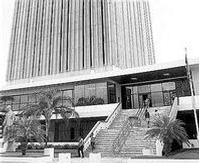
The Bank of Jamaica, headquartered at Nethersole Place on the Kingston waterfront, reported on September 8 that private remittances had grown 1.7 per cent in four months to April 2006, while the IDB has reported that regionally, flows will climb to US$60 billion in 2006. - File
Remittance flows to the Caribbean and Latin America will jump a near 12 per cent this year, according to estimates of the Inter-American Development Bank's Multilateral Investment Fund (MIF).
At the same time, a new market study released this week suggests that nationals abroad are now more willing to invest in their home countries.
Its findings are likely to give fillip to low-key attempts by policymakers to devise strategies for exploiting remittances Ñ which are largely transmitted in small amounts to relatives Ñ as a pool of developmental funds, instead of the consumerism the flows tend to finance.
This year migrants are projected to send US$60 million to the region, a more than six million premium on the US$53.6 million that flowed in during 2005.
Jamaica's latest monthly Balance of Payments report, reflect a 1.7 per cent increase in private remittances over January to April 2006, the island's central bank reported this week.
Last year, remittance flows to Jamaica topped US$1.6 billion.
MIF manager Donald Terry, announced the regional figures at a press conference ahead of the 9th Microenterprise Forum, which ends today in Quito, Ecuador.
Poverty alleviation
"Remittances already are the largest poverty alleviation pro-gramme in several countries of this region," said Terry.
"The challenge now is to turn these flows into a major tool for economic development."
A market study on remittances and investments done by the Miami-based firm Bendixen and Associates, and presented at the press conference, concludes that a greater number of migrants are now interested in investing monies in Latin America and the Caribbean.
"We found significant interest among people who receive and send remittances in investing in their homelands," said pollster Sergio Bendixen who, according to the IDB, has conducted surveys on remittances for the MIF in the Americas, in Europe and Japan.
"This represents a huge change from the past."
Areas of interest include real estate, more specifically home construction, and business development.
Five years ago, said Benixden, 95 per cent of migrants had invested in their homelands, compared to one third now who have put money largely in real estate.
Financial products
The market study, to be discussed at the Quito conference today, found that migrants were largely interested in financial products and services linked to life and health insurance and savings products, followed by credit for housing and education, but that they wary of their countries banks and financial institutions because they see no clear link between "their money transfers and the opportunity to build a credit history," said the IDB.
"This research points up the great impact these flows could have on this region's economic development, but for that to happen we need the public and private sector and civil society to get involved, and not just the families who send and receive remittances," said Terry.
business@gleanerjm.com

